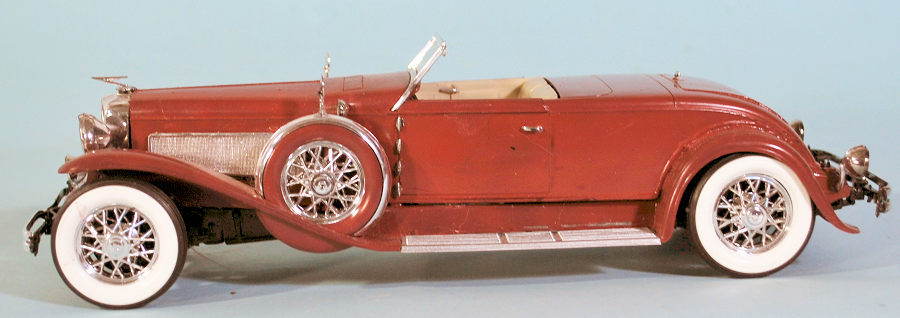
Monogram 1/24 1934 Duesenberg SJ
| KIT #: | 2302 |
| PRICE: | $ |
| DECALS: | None |
| REVIEWER: | Tom Cleaver |
| NOTES: | Long OOP |

| HISTORY |
E. L. Cord, owner of the Auburn Automobile Company, and other transportation firms, bought the Duesenberg Motor Corporation on October 26, 1926, for the brothers' engineering skills, talent and brand name. He intended to produce a car to rival the size, power, and luxury of top European brands such as Hispano-Suiza and Rolls-Royce.
After Cord's takeover, the new company was renamed "Duesenberg, Inc." Fred Duesenberg continued in the new organization with the title of vice president in charge of engineering and experimental work. Fred Duesenberg died of pneumonia on July 26, 1932, resulting from injuries sustained in an automobile accident in which he was driving a Murphy SJ convertible. His brother, Augie, took over Fred's duties as chief engineer and Harold T. Ames became president of Duesenberg, Inc.
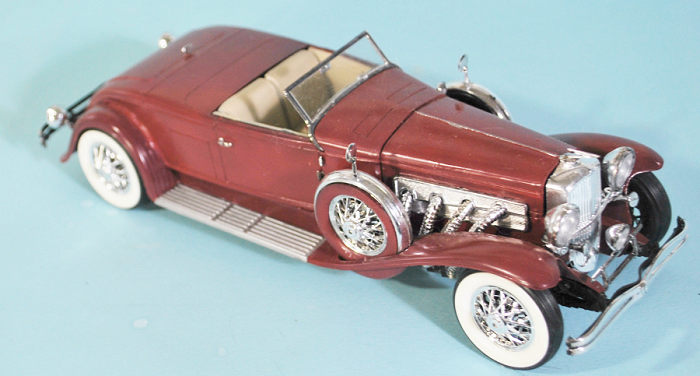 Fred's
brother August, who had played an important role in the development of the
Model A and its variant, the rare X, had nothing to do with the initial
design of the J and had no formal connection with Duesenberg, Inc. until
later. According to the expert Marshall Merkes, "Cord did not want Augie
around."However, all Duesenberg racing cars produced after 1926 were built
by Augie in an enterprise that functioned separately, and in a building
apart from the main Duesenberg plant. He was also responsible for a number
of engineering achievements like the superchargers developed for both the
Auburn and Cord motorcars.
Fred's
brother August, who had played an important role in the development of the
Model A and its variant, the rare X, had nothing to do with the initial
design of the J and had no formal connection with Duesenberg, Inc. until
later. According to the expert Marshall Merkes, "Cord did not want Augie
around."However, all Duesenberg racing cars produced after 1926 were built
by Augie in an enterprise that functioned separately, and in a building
apart from the main Duesenberg plant. He was also responsible for a number
of engineering achievements like the superchargers developed for both the
Auburn and Cord motorcars.
The Duesenberg Model J luxury automobile was intended to compete with the most luxurious and powerful cars in the world, it was introduced in 1928, the year before the stock market crash that led to the Great Depression.
The 420 cu in straight eight Model J motor was based on the company's successful racing engines of the 1920s; though designed by Duesenberg they were manufactured by Lycoming, another company owned by Cord. In normally aspirated form, it produced 265 horsepower from dual overhead camshafts and four valves per cylinder. It was capable of a top speed of 91 mph and 79 mph in 2nd gear. Other cars featured a bigger engine but none of them surpassed its power. It was both the fastest and most expensive American automobile on the market.
The chassis cost $8,500 ($189,820 in 2023 dollars) and $9,500 after 1932 ($212,151 in 2023 dollars). At a time when the average U.S. physician earned less than $3,000 a year ($66,995 in 2023 dollars, most completed vehicles fell between $13,000 and $19,000 ($424,302 in 2023 dollars, with two J's reaching $25,000 ($558,293 in 2023 dollars. A Duesenberg marketing slogan was that the only car that could pass a Duesenberg was another Duesenberg—and that was with the first owner's consent.
The powerful 320 hp supercharged "SJ" model developed by Fred Duesenberg and introduced in May 1932, was capable of 104 miles per hour in second gear with a top speed of 135–140 mph in third. Performance included zero-to-60 mph time of eight seconds and 0–100 mph in 17 seconds in spite of the unsynchronized transmissions, at a time when even the best cars of the era were not likely to reach 100 mph. Duesenbergs generally weighed around two and a half tons; up to three tons was not unusual, considering the wide array of custom coachwork available.
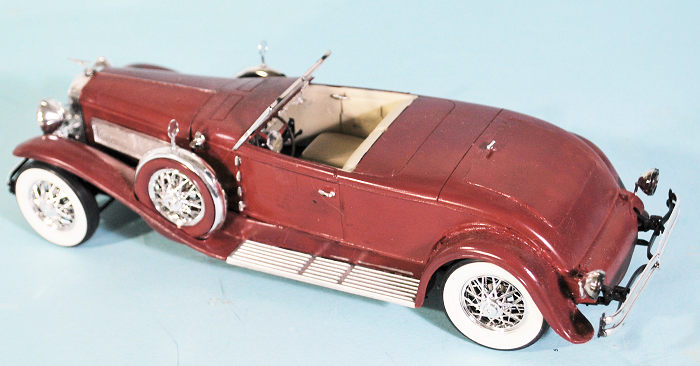 The
SJ's supercharger was located beside the engine; the vertical driving shaft
necessitated a redesigned exhaust manifold arrangement; originally this took
the form of a one-piece eight into one Monel manifold that re-routed the
exhaust away from the engine, outside the engine compartment and through a
single hole in the right front fender. The eight port manifold was found to
be prone to cracking and was quickly superseded by a second manifold
arrangement that routed four branches through the right side panel of the
hood and right front fender. At least one supercharged car retains its
original eight port manifold while most can be recognized by the four
exposed exhaust pipes encased within bright flexible metal conduit tubes, a
design which Cord registered as a trademark and used in his supercharged
Cords and Auburns. Only 36 SJs were ever built.
The
SJ's supercharger was located beside the engine; the vertical driving shaft
necessitated a redesigned exhaust manifold arrangement; originally this took
the form of a one-piece eight into one Monel manifold that re-routed the
exhaust away from the engine, outside the engine compartment and through a
single hole in the right front fender. The eight port manifold was found to
be prone to cracking and was quickly superseded by a second manifold
arrangement that routed four branches through the right side panel of the
hood and right front fender. At least one supercharged car retains its
original eight port manifold while most can be recognized by the four
exposed exhaust pipes encased within bright flexible metal conduit tubes, a
design which Cord registered as a trademark and used in his supercharged
Cords and Auburns. Only 36 SJs were ever built.
The Model J quickly became one of the most popular luxury cars as well as a status symbol in the United States and Europe, driven by the rich and famous, among them Al Capone, Evalyn Walsh McLean, Greta Garbo, Ginger Rogers, Howard Hughes, Mae West, Marion Davies, Tyrone Power, Clark Gable, Bill "Bojangles" Robinson, and William Randolph Hearst; members of European royalty such as the Duke of Windsor, Prince Nicholas of Romania, Queen Maria of Yugoslavia, and Kings Victor Emmanuel III of Italy and Alfonso XIII of Spain. The last was very keen on motoring and chose his now missing Duesenberg J, among his cars, to go to exile after the proclamation of the Second Spanish Republic.
Ultimately it was newly wealthy Hollywood that kept Duesenberg alive as the Depression deepened, and through much of the 1930s. It was so imposing that many Hollywood stars, such as James Cagney, posed next to the car to promote their careers.
The final evolution of the Duesenberg engine was ram-air intakes, which were added to some of the last supercharged models to produce 400 hp, referred to as "SSJ". Of the 481 Model Js produced between 1928 and 1937, about 378 survive. Duesenberg ceased production in 1937 after Cord's financial empire collapsed. The last one ever made was assembled from leftover parts between 1938 and 1940.
Duesenbergs became far less popular during World War II; by 1942, used specimens were abundant and cheap, with advertised prices averaging around $700 ($13,053 in 2023 dollars) for cars in excellent condition. A few used Model Js were advertised for around $300 to $400, with some ultimately selling for only $100 or $200.
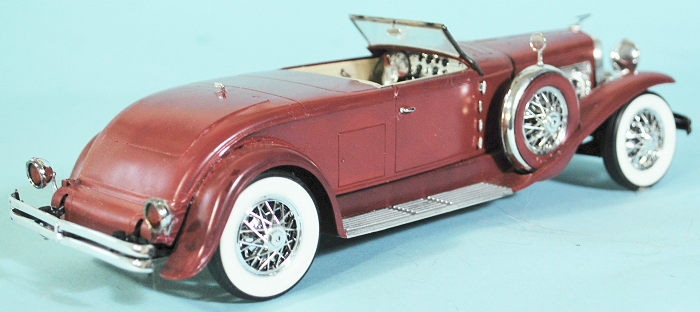 Business rebounded in the 1950s, when classic and vintage cars became
popular among collectors. Several Model Js were advertised in The New York
Times in the fall of 1950, at prices as low as $500, though an exceptional
restored example could exceed $2,000 ($25,328 in 2023 dollars) which was
still within the reach of the average working American.
Business rebounded in the 1950s, when classic and vintage cars became
popular among collectors. Several Model Js were advertised in The New York
Times in the fall of 1950, at prices as low as $500, though an exceptional
restored example could exceed $2,000 ($25,328 in 2023 dollars) which was
still within the reach of the average working American.
By 1959 a decent example could not be bought for less than $4,000, and an exceptionally fine specimen could approach $10,000 ($104,521 in 2024 dollars). A record price of $12,000 had been paid for a Duesenberg J in a private sale that year. In 10 years' time, by 1969, a Model J could fetch anywhere between $20,000 and $75,000 ($623,140 in 2024 dollars). A record price of $205,000 ($1,266,518 in 2024 dollars) was set at an auction in 1974 for a model J, surpassing Adolf Hitler's personal Mercedes-Benz 770, which sold for $153,000 the year prior.
In 2018 a Duesenberg SSJ formerly owned by Gary Cooper was sold at auction for $22 million, making it the most expensive American car ever sold.
Liberace used a replica Duesenberg SJ encrusted with Austrian rhinestone crystals during his stage performances. The vehicle later went on to be exhibited at the Liberace Museum in Las Vegas, Nevada, and at The Cosmopolitan of Las Vega; its current location is at the "Liberace Garage" in Las Vegas.
| THE KIT |
This is one of the Monogram “Classic American Cars” originally released in the 1960s. The Duesenberg Model J was also released at this time.
| CONSTRUCTION |
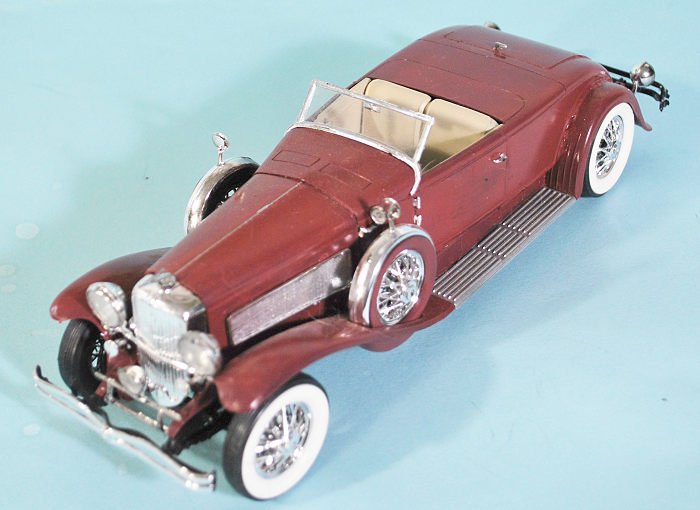 The kits
are “1960s fit,” which means they should be treated like a modern limited-run
kit in order to get the best final result. The plastic does not respond to
modern “hot” glues like Tamiya Extra-thin. I assembled this kit using CA-glue. I
did not install the engine, opting for a “curbside” model.
The kits
are “1960s fit,” which means they should be treated like a modern limited-run
kit in order to get the best final result. The plastic does not respond to
modern “hot” glues like Tamiya Extra-thin. I assembled this kit using CA-glue. I
did not install the engine, opting for a “curbside” model.
I closed up the rumble seat option, which involved filling the gap on all four sides of the trunk lid after using some plastic strip around the opening from inside to give “step” for the trunk lid to be glued to. I left off the cargo trunk (which really is a trunk).
The most important thing to get right is for all four wheels to touch the ground. Accomplishing this involved bending the axles of all four tires until all touched ground, then “freezing” that position with CA glue applied with Zap to get it to cure fast.
| COLORS & MARKINGS |
I read that Clark Gable’s SJ was “plum colored” and decided to do what might have been his (he drove his at 150mph on the road out to Palm Springs once it was paved, according to legend). I used Vallejo “plum red”, while painting the seats with Gunze “sail color” for the leather covering.
| CONCLUSIONS |
Another in the “Cars I Would Buy If I Won The Powerball Solo” Collection.
16 May 2024 Copyright ModelingMadness.com. All rights reserved. No
reproduction in part or in whole without express permission from the editor.
If you would like your product reviewed fairly and fairly quickly, please
contact the editor or see other details in the
Note to
Contributors.